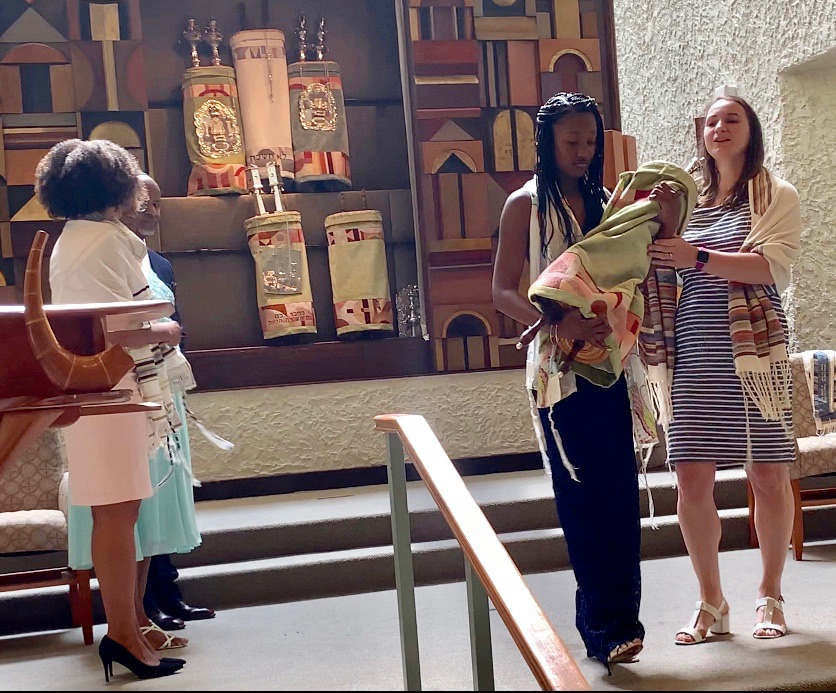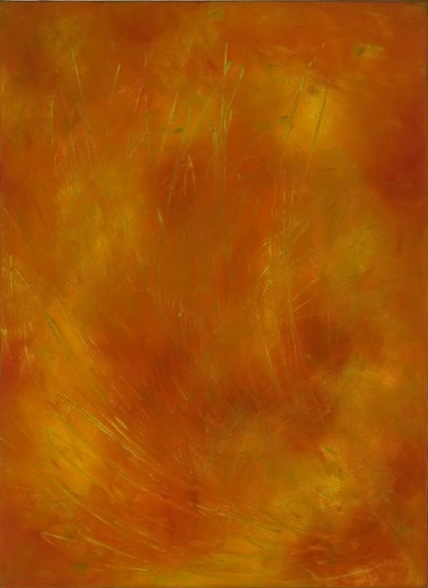A program involving text study, the creation of blessings, and tzedakah, welcoming girls into the rich continuum of Jewish women’s experience
Detail from “Miryam’s tallit” by Anne Young
Introduction
Even before it had a name, adolescence was a stormy time, both for young people trying to make their way through this difficult adult passage between childhood and adulthood and for the adults who live with them. Bodies are changing so rapidly and dramatically and idiosyncratically that many kids are frightened, stunned, and ashamed. Kids experience changes in their minds, too, in their ability to ask different questions than they have ever asked before, and to challenge norms that they have depended upon and taken for granted. This is often a time when childhood friends are exchanged for other companions who may represent cultural, artistic, and personal choices previously unthinkable or unavailable to the pre-adolescent. And young people’s spirits, often so free in the latency period of childhood, change too as waves of hormones roil, crest and crash.
Since the sixteenth century, Jews have responded to this time of intense physical, intellectual, social and spiritual change by welcoming boys into communities of Jewish men through bar mitzvah, a rite of passage that welcomes boys in the community of adult Jewish men. Seventy-five years ago, Judith Kaplan, at the instigation of her iconoclastic father, Rabbi Mordecai Kaplan, broke the gender barrier when she chanted from the haftarah portion at a Shabbat morning service shortly after her twelfth birthday, and symbolically entered the community as a responsible and educated participant.
What does it mean for a girl to become a bat mitzvah at the end of the twentieth century? For many liberal educators committed to an egalitarian vision, the challenges of teaching and training girls are similar to those faced when dealing with boys. Educators focus on the content and context of youngsters’ preparation, teaching basic synagogue skills while acknowledging the richness and range of both the girls’ own families and the communities of which they are a part. But what of the particular challenges faced by girls at this crucial time in their lives? This article describes a program designed especially for adolescent girls and their mothers, using bat mitzvah as preparation for Jewish womanhood in a changing Judaism.
Much recent scholarship has focused on the differences between girls and boys and learners and as moral agents (see, for example, the work of Carol Gilligan in In A Different Voice: Psychological Theory and Women’s Development, Lyn Mike Brown and Carol Gilligan, Meeting at the Crossroad: Women’s Psychology and Girls’ Development, and Myra and David Sadker in Failing at Fairness: How America’s Schools Cheat Girls.) Psychologist Mary Pipher has made some trenchant observations about how our culture is toxic for adolescent girls in her Reviving Ophelia: Saving the Selves of Adolescent Girls. Pipher writes,
| With puberty girls crash into junk culture. One way to think about all the pain and pathology of adolescence is to say that the culture is just too hard for most girls to understand and master at this point in their development. They become overwhelmed and symptomatic.1 |
One way that committed, involved Jewish parents and educators can help our daughters confront this “junk culture” is by fortifying their sense of self, and helping them to see their changing selves in the context of Judaism. The pre-bat mitzvah year is a perfect time to focus on girls’ growing awareness of themselves, in relationship to their peers, their families, and the various communities of which they are a part. The preparation for the bat mitzvah itself can be seen in larger context of preparing our daughters for lives of intentional choices, thoughtful commitments, and joyful service.
Planning the Program
In the fall of 1995, Ma’yan, the Jewish Women’s Project of the JCC of Manhattan brought together five Jewish educators to explore the creation and implementation of a program for pre-teen girls that would pose questions that could be discussed and pursued during the bat mitzvah year. 2 We felt the urgency of working with girls, but acknowledged that this process was not only about girls’ journeys. Parents of adolescents have enormous needs to communicate with other parents, and most lack any opportunities to share concerns, questions, and insights with their peers. We shared our own concerns as women about the challenges we had faced at this age, including the challenge of maintaining open communication with our own mothers. The mother/daughter bond is rich and complex, and has recently been the focus of some scholarly attention.3 None of us, however, knew of specifically Jewish treatments or approaches to mother/daughter issues. We were intrigued by the possibility of pursuing this essential connection as part of the preparation for bat mitzvah. We decided to develop a program for bat mitzvah girls and their mothers, or for girls and another significant woman in their lives.
Our original planning team ranged in age from womenin our twenties to our fifties, and included three Jewish educators, and administrator, and two rabbis. We planned a four-hour workshop around the following goals:
- to provide an opportunity for mothers and their pre-bat mitzvah daughters to share an experience explicitly designed for them
- to welcome girls into the rich continuum of Jewish women’s experience
- to use innovative approaches to the study of traditional texts that reflect a commitment to feminist hermeneutics
- to open a discussion about blessings and and traditional and innovative language of blessings that welcomes girls and their mothers to reconsider berakhot in the context of their lives
- to set a precedent for celebrating the achievements and contributions of women as integral to the past, present, and future
- to underscore the imperative of tz’dakah as an obligation incumbent upon all Jews, and to offer a range of suggestions for girls of bat mitzvah age to fulfill this obligation
- to acknowledge that this rite of passage is rich with possibilities for study, celebration and service for the individual girl, her family, and the communities of which she is a part.
The Workshop
The workshop, which was offered first in the fall of 1995 and has since been presented in several different venues, takes place during the course of a full, fast-paced afternoon with a range of activities that would enable each girl and each adult to participate comfortably while feeling challenged intellectually and spiritually. We included singing, art projects, study, writing, and discussion in mother-daughter pairs, and in larger groups of mothers and daughters. Some may wish to include groups of girls only and mothers only.
This program can be implemented alone or as a complement to existing education programs around bat mitzvah. If some portion of this workshop replicates existing programming, the workshop can be reorganized or redesigned to fit particular needs.
The workshop has 7 distinct components:
- Welcome
- Handmade Midrash
- Living Torah: Lives as Text
- Jewish Women’s History: Role Models for Living
- Tzedakah: Justice Work
- Blessings
- Havdalah as ending and beginning
I. Welcome
After checking in, participants are sesated in mother-daughter pairs at round tables and welcomed with song. Each participant receives a packet containing the written materials they will need in the course of the workshop. 4 Debbie Freidman’s powerful “Brukhot Ha’Baot“ can be used as a welcome, followed with “Makom Kadosh.” One of the educators then introduces the day, walking participants through the course of the workshop and introducing journey as a metaphor for the process of becoming a Jewish woman.
This is followed by teaching the text of Lech Lecha (Genesis 12), found on the resource text sheet in each packet, followed by a discussion of what it means “to be a blessing.” The song “Lekhi Lakh“ can then be taught, setting the tone for the day. The discussion leader suggests that Abraham was the first, but not hte only Jew called to “be a blessing,” and that each one who has come to participate may, in the course of a day, realize their power as a source of blessing.
II. Handmade Midrash
Text study continues with an exploration of two excerpts from Exodus, Chapters 2:1-8 and 15:20-21. Initial questions help participants to identify the actors and the actions described in each text. The first of these texts introduces but does not name Miriam. Leaders ask, “What do we learn about “the daughter of Levi” in this text?” “For whom is she a blessing?” The second text begins with a Miriam transformed.
Once this text has been read aloud by one of the participants, the following questions can be asked, “How is the depiction of Miriam different than the first description of her? How does the text let us know that something about her has changed? What is the mood of this excerpt?” Participants, girls and adults alike, are then asked to consider themselves as Miriams, and to fashion, with the colored paper and glue that has been provided in the center of each table, their conception of how the daughter of Levi in Chapter 2 became the Miriam of Exodus 15. Each participant is then invited to create her own “handmade midrash” that fills in the “white spaces” between text #1 and text #2, addressing the question: “How did Miriam change or develop or move from the first time we meet her through the text and the second time she is introduced to us?” Participants are encouraged to work independently, without using scissors or any markers or pens.
The simple material invite participation from all, even those who rarely exercise their creative potential. After about 10 minutes, participants can be asked to share their creations with others, first with those at their table, and then, depending on the total number of participants, with the entire group. Post the midrashim on the wall for the duration of the workshop so that everyone can share the delight of one another’s creativity. This activity concludes with the singing of a Miriam song, found in the workshop packet.
III. Living Torah: Inheriting text – A mother/ daughter activity
For the next activity, each participant receives a piece of paper with a sketch of a tree superimposed on an empty scroll, and each person is invited to fill in her own name on a designated branch of the tree. Then each participant is asked to create a family tree with the names of women in her life — women she admires, women who have influenced her, women she loves. She may include both women she knows and women she has never met. After a short period of time, each participant is asked to take a marker of a different color and, around the margins of her tree, to list the qualities of the most important one or two women she has chosen. Each participant is then asked to share the one or two most important women from her tree/scroll with her mother/daughter, or in the case of a couple who are not mother and daughter, her workshop partner. After that sharing, each mother chooses one of the qualities that their daughter has chosen as admirable and tells her daugher how she already embodies this quality. If time permits, the daughter can repeat this process with her mother. This process of acknowledging and mirroring desired qualities is often noted as lacking in adolescents at risk, and sets a tone for the day of mutual respect and care.
IV. Jewish Women’s History: Role Models for Living
To concretize the rich discussion of role models that has just concluded, this exercise uses posters, photographs or drawings of historical figures to introduce Jewish women as models for young women’s lives. Many may wish to use the Women of Valor poster produced by the Jewish Women’s Archive,www.jwa.org. Each set of three posters is accompanied by a resource guide which includes a biography, timelines and primary sources for each woman. The educator who leads this portion may speak about one or more women, making explicit connections to the two preceding activities. This section can conclude with a song, such as “The Youth Shall See Visions.”
V. Tzedakah: Justice Work
After a very brief introduction to the imperative of social justice work in the consciousness and behavior of each Jew and definitions of the terms tz’dakah, tikun olam and mitzvah, each participant is asked to look in her packet for a puzzle piece. When she finds it, she is asked to find the seven others who hold puzzle pieces of the same color, and then to share what is written on her piece said before completing the puzzle. Each piece had one suggestion for incorporating an act of tzedakah into the bat mitzvah preparation or the bat mitzvah service or the celebration When the pieces were assembled, they made up a world upon which is written: Tikun olam: tz’dakah heals the world.
Participants are then asked to take their seats in mother-daughter pairs. At this point in the workshop, one or two teen aged girls who completed a tz’dakah project of some kind during their bat mitzvah year can share their experiences with the group. This can be a particularly powerful presentation for the younger girls in the group who listen to older teens with a different kind of attention than to adults. In groups of four, two daughters and two mothers, participants begin to talk about how they, in some small way, can contribute to tikun olam, how they can think about giving a discrete amount of time towards a project or idea or enterprise that increases justice in the world. Each daughter is then asked to begin to fill out, with the help of her mother, the “My Bat Mitzvah Tzedakah Project” sheet, which is included in the packet. Participants are encouraged to begin the process of thinking about a doable project that can be completed in a reasonable amount of time. The leader should emphasize that planning the project carefully is a crucial first step.
VI. Blessings
This final learning component introduces traditional blessing formulae to participants and welcomes both mothers and daughters to compose or create blessings that may be used during the bat mitzvah experience. Musical settings for the “Priestly Blessing: Yevareichekha” and “Shehecheyanu” are particularly useful here.
The group can be divided here by generation. The mothers can be taught the Priestly Blessing, and the daughters the “Shehecheyanu.” Each blessing is broken down into its component parts and studied. Depending on available time, the discussion on language and metaphor can be quite rich, including exploring issues of continuity and change, communal and individual blessings, and the role such a blessing might play in the larger prayer context of an individual or community. Participants are then invited to create, individually or in small groups, a blessing that they can use as part of the bat mitzvah celebration. The mothers can create a blessing that they can introduce before the bat mitzvah or use for the first time at some point during the bat mitzvah celebration. The daughters can develop a prayer that they can use during or after their bat mitzvah celebration.
VII. Endings and Beginnings
The workshop ends, as it began, in song. Mothers and daughters are asked to come back together and to stand, in couples, around the room. Some may wish to conclude with a havdalah ceremony, which is introduced, with a clear explanation that the traditional time to celebrate havdalah is Saturday at sundown, but the tradition teaches taht we can celebrate this demarcation of the end of Shabbat and the beginning of the new week up until Tuesday evening. The leader may continue by explaining that the ceremony of havdalah reminds us that all that is intertwined is also distinct, and that part of what we had learned in the course of our time together is that we have relationships with both our tradition and with our mothers that may resemble the havdalah candle. Like the candles, the lives of mothers and daughters are forever connected even when we feel most distinct. Participants are encouraged to enter the blessings with open hearts, celebrating the sweetness of saying farewell the special time spent together.
With song, havdalah is celebrated with a single cup of wine, a single container of spices and a single candle for the entire group. The blessings continue with the special blessings written by each mother and daughter, said quietly to one another. The havdalah can conclude with the singing of Miriam HaNiviah. The concluding ceremony can also skip the havdalah and simply utilize the blessings written by mother and daughters. Tefilat haDerekh can be a fitting conclusion to the workshop.
VIII. Evaluations: Participants and Planners
Participants are asked to complete a short evaluation which is included in the participant packets. Depending on the context of the workshop, planners may wish to follow up with particpants in some way. Some may wish to send congratulatory notes to each of the girls at the time of their bat mitzvah.
Evaluation
The evaluations of this program have been overwhelmingly positive. Both mothers and daughters appreciate the opportunity to refocus the energy of their connection on finding shared areas of concern: becoming a woman, claiming a past, charting a future. The lightness of the presentation opens new arenas of discourse for parents and children who too often find themselves stuck in confrontational patterns of anger and mutual misunderstanding. The integration of music, art, and study provides a new and welcome model of Jewish education for many. The celebration of women’s lives is particularly welcomed by many mothers, for whom this is a first opportunity to think about and share their own experiences of Jewish women’s strengths and contributions. The workshop offers a unique opportunity for daughters and mothers to share a Jewish educational experience, and to share an experience that can have rich resonance as the bat mitzvah celebration itself draws near.
Participants’ own words provide one evaluative measure of the program. The words of a daughter: “I really loved the songs at the end; at the Havdalah service. It was very moving. It made you forget everything around you and only remember that everyone here was loving their parent or child, and I don’t think there could ever be any more love than that in one room at one time. You could have taken it and rationed it around the whole world, and there would have been plenty left for the women who started it.” The words of a mother: “I loved having the opportunity to spend this time with my daughter. I think we gained something immeasurable from it–I was able to show her how much I love her–something I’m not always able to do. I loved being in a room filled with Jewish women and their daughters. The warmth and unity of the group was palpable.
This workshop represents one distinctly Jewish response to the junk culture that is threatening so many of our daughters. When integrated into strong synagogue and school education programs, programs like this can inspire, instruct, and guide the next generation of Jewish leaders and teachers.
————————-
Unpublished paper; used by permission of the author












